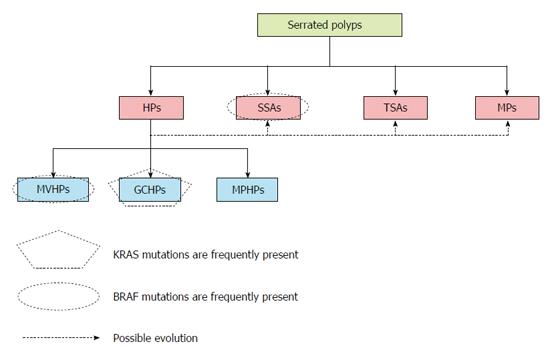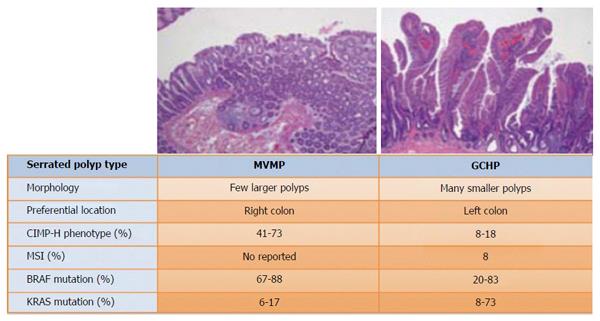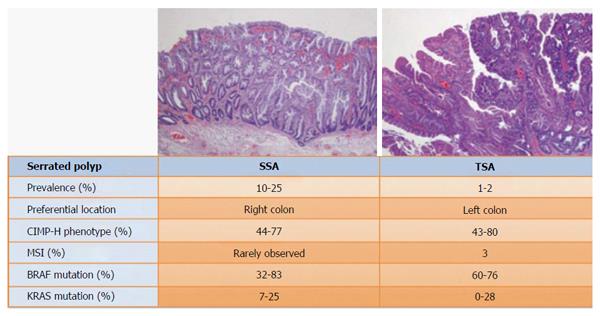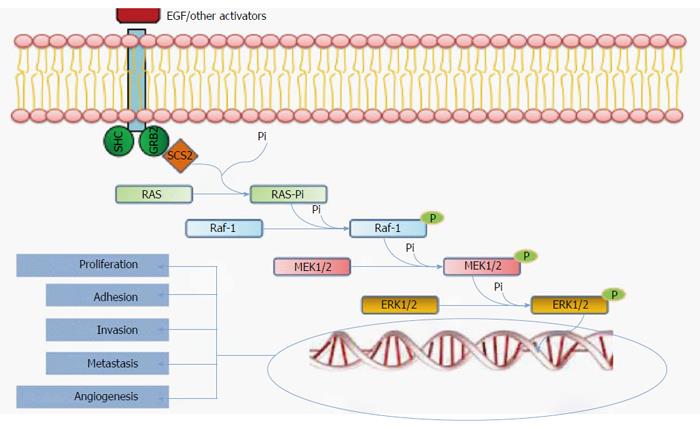Copyright
©The Author(s) 2016.
World J Gastroenterol. Apr 7, 2016; 22(13): 3516-3530
Published online Apr 7, 2016. doi: 10.3748/wjg.v22.i13.3516
Published online Apr 7, 2016. doi: 10.3748/wjg.v22.i13.3516
Figure 1 Types of serrated polyps.
Serrated polyps can be divided into four types: hyperplastic polyps (HPs), sessile serrated adenomas (SSAs), traditional serrated adenomas, and mixed polyps (MPs). The polyps can also be genetically characterized according to their CIMP, BRAF, KRAS, and MSI status, and certain patterns are found frequently for each category of polyp. Both microvesicular hyperplastic polyps (MVHPs), which are an HP subset, and SSAs have BRAF mutations more often than KRAS mutations. Conversely, goblet cell hyperplastic polyps (GCHPs), another HP subset, more frequently show KRAS mutations. BRAF mutations often correlate with high-grade CIMP CRC, whereas KRAS-mutated serrated polyps are more commonly found in low-grade CIMP. MPHP: Mucin-poor hyperplastic polyp.
Figure 2 Features of microvesicular hyperplastic polyps and goblet cell hyperplastic polyps.
Microvesicular hyperplastic polyps (MVHPs) and goblet cell hyperplastic polyps (GCHPs) are premalignant lesions that differ mainly in their location and morphology. MVHPs are more likely to occur as a few large polyps in the ascendant colon, and GCHPs are more likely to occur as multiple small polyps in the left colon. Each can become senescent or evolve into another type of polyp. Although they can transform into other adenomas, MVHPs more often evolve into sessile serrated adenomas (SSAs), and GCHPs more often evolve into traditional serrated adenomas (TSAs). The prevalence of KRAS mutations is higher in TSAs, while BRAF mutations are more prevalent in SSAs.
Figure 3 Features of sessile serrated adenoma and traditional serrated adenomas.
Pathological analysis shows that sessile serrated adenoma (SSAs) are more common than traditional serrated adenomas (TSAs). While TSA is preferentially located on the left colon, SSA is preferentially located on the right side. In addition, both SSAs and TSAs are found in high-grade CIMP tumors, although several studies show a relationship between low-grade CIMP tumors and TSAs. BRAF mutations are often observed in SSA, whereas KRAS mutations are often observed in TSAs. Contrary to what is found in serrated adenocarcinomas, MSI is almost never present in serrated polyps.
Figure 4 MAPK pathway.
This simplified diagram of the MAPK pathway shows the RAS/Raf-1/MEK/ERK pathway. RAS mutations are found in 36% of serrated polyps, and Raf-1 mutations are found in 9%-11%. These mutations promote gene transcription and cellular growth that results in cellular adhesion, invasion, metastasis, and angiogenesis.
Figure 5 Serrated pathway.
This diagram shows the chronological changes that occur during the development of neoplasia. MAPK mutations do not affect just one gene; rather, they affect some genes more than others. Gene methylation is successive rather than simultaneous and contributes to the progression of the serrated lesion. Depending on which genes are most affected, serrated cancers can be classified into three subtypes. GCHP: Goblet-cell hyperplastic polyp; MVHP: Microvesicular hyperplastic polyp; SSA: Sessile serrated adenoma; TSA: Traditional serrated adenoma.
Figure 6 Polyp features according to location.
Half of serrated adenocarcinomas (SACs) are located on the right colon. KRAS-mutated polyps are preferentially left-sided. However, polyps with BRAF mutations dominate those found on the right side of the colon. TSA: Traditional serrated adenoma; SSA: Sessile serrated adenoma.
- Citation: Murcia O, Juárez M, Hernández-Illán E, Egoavil C, Giner-Calabuig M, Rodríguez-Soler M, Jover R. Serrated colorectal cancer: Molecular classification, prognosis, and response to chemotherapy. World J Gastroenterol 2016; 22(13): 3516-3530
- URL: https://www.wjgnet.com/1007-9327/full/v22/i13/3516.htm
- DOI: https://dx.doi.org/10.3748/wjg.v22.i13.3516














